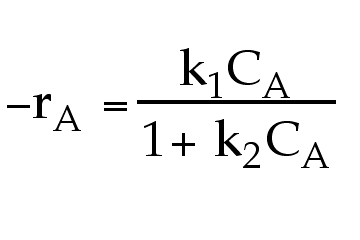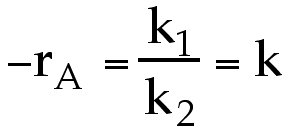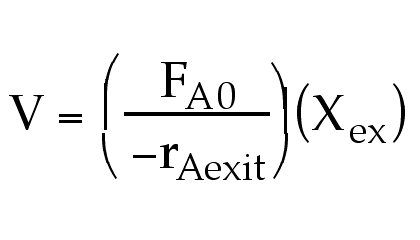- What is the frequency factor and where can we get values for it? What is it dependent on?
There are tables in the literature. For a first-order gas phase reaction, an order of magnitude value is A=1013s-1. Generally the frequency factor is independent of temperatures, however on occasion it can be a weak function of temperature.
See p.944
- Why is the limiting reactant our basis of calculation?
If the limiting reactant is not chosen as the basis of calculations, one could calculate a NEGATIVE concentration.
See Example 3-5 (p.90).
- What is the relationship between the KC in chemistry (A + B <--> C)

and the k in the rate laws?
KC is an equilibrium constant, and k is specific rate constant and has units of time. The concentration equilibrium constant KC does not.
- How does the k (specific reaction rate) depend on pressure, or does it?
ONLY in very very rare instances at very high pressures such as, 6000 atm is k a function of pressure.
See p.220 and CD-ROM on "Critiquing what you read."
- What is the frequency factor, A, in the Arrhenius Equation;
I want to know what it's physical meaning is and/or what it is a frequency factor.
Arrhenius Equation is k = Ae-E/RT
The frequency factor, A, is the coefficient of the exponential term.
It has the same units as k.
It is related to the number of collisions between molecules.
See p.942 and 943.
- What does the overall order of the power law model indicate?
One can classify reactions by their overall order of reaction.
- Who determines all the rate laws?
These can be found in the literature, journals, books, tables, etc.,
see the footnote on p.75.
They can also be determined in the laboratory.
See Ch.5
- How is rA
 determined as a function of concentration and how
do we find the rate law of a chemical reaction if this is not elementary?
determined as a function of concentration and how
do we find the rate law of a chemical reaction if this is not elementary?
The rate law is determined only from experiment, see chapter 5. Also see chapter 7 for a discussion of non-elementary reactions.
- Is the reaction rate affected by conditions other than temperature?
It is a function of concentration of species participating in the reaction
and whether or not there is a catalyst.
- Why are the units for k different depending on the rate law expression?
So that -rA has always the same units (mol/dm3 s), no matter what the
reaction order.
- What is the physical meaning of d?
Change in total number of moles (for complete conversion) per mole of
limiting reactant.
- What is the physical meaning of e?
Does it matter if e is negative?
e=yAo d
It is the change in total number of moles at complete conversion (i.e. X = 1)
per total number of moles fed to the reactor. The parameter e
can be either positive or negative (see Ex-3-7, p 100).
- Are there any factors on which the activation energy is dependent upon?
The activation energy is a constant for each reaction (at least in a
range of temperatures). It is related to the strength of the chemical bonds that must be broken and formed for the chemical reaction to take place.
- What type of reaction is zero-order?
For example, if the rate law is  we can see that for large values of k2CA ( k2CA >> 1) the rate law becomes
we can see that for large values of k2CA ( k2CA >> 1) the rate law becomes  , i.e. apparant zero order. If a zero-order reaction is conducted in a batch reactor, the concentration is a linear function of time (i.e. dC/dt = k and CA= CAo - kt).
, i.e. apparant zero order. If a zero-order reaction is conducted in a batch reactor, the concentration is a linear function of time (i.e. dC/dt = k and CA= CAo - kt).
- Why do we evaluate the volume of a CSTR at the end point of the
(1/rA) vs X curve, while for PFR we calculate the area
underneath?
A CSTR always assumed to be perfectly mixed. A sample of the reactive mixture taken anywhere from inside the reactor will be the same as that at the exit. Consequently, the exit
conversion and thus 1/rA at the exit are the same as they are inside the reactor.  On the other hand, in the PFR,
the conversion (and thus 1/rA) changes along the length of
the reactor; the rate is large at the entrance where the reactant concentrations are high and the conversion is
low and small at the exit where the reactant concentrations are low and the conversion is high.
On the other hand, in the PFR,
the conversion (and thus 1/rA) changes along the length of
the reactor; the rate is large at the entrance where the reactant concentrations are high and the conversion is
low and small at the exit where the reactant concentrations are low and the conversion is high.
- Why do we use CSTRs if for the same conversion they always have
larger volume than PFRs for isothermal reactions?
CSTRs are used for liquid phase reactions. They are cheaper,
easier to use, and since the reactants are well mixed, there are not hot
spots (hot spots might cause an explosion).
- Does the weight of the solid catalyst matter when setting up stoichiometric
tables and concentration equations?
No! Stoichiometry only depends on the reaction chemistry and inert gases
or liquids present.
- How are phase changes taken into account for reactor sizing?
The equations for concentration, in terms of conversion, will change once a phase change begins to occur. Consequently, the expression for the rate law as a function of conversion might have
different expressions for different conversion ranges. See example 3-10,
p 108.
- How do you know whether to use 2 points, 3 points, etc., to
calculate an integral and evaluate the area under the curve for sizing
a PFR?
It depends upon the steepness of the function you want to integrate.
The greater the steepness, the larger the number of points you have to
use. The quadrature methods are given in section A.4, p 924.

 determined as a function of concentration and how
do we find the rate law of a chemical reaction if this is not elementary?
determined as a function of concentration and how
do we find the rate law of a chemical reaction if this is not elementary?
 we can see that for large values of k2CA ( k2CA >> 1) the rate law becomes
we can see that for large values of k2CA ( k2CA >> 1) the rate law becomes  , i.e. apparant zero order. If a zero-order reaction is conducted in a batch reactor, the concentration is a linear function of time (i.e. dC/dt = k and CA= CAo - kt).
, i.e. apparant zero order. If a zero-order reaction is conducted in a batch reactor, the concentration is a linear function of time (i.e. dC/dt = k and CA= CAo - kt).
 On the other hand, in the PFR,
the conversion (and thus 1/rA) changes along the length of
the reactor; the rate is large at the entrance where the reactant concentrations are high and the conversion is
low and small at the exit where the reactant concentrations are low and the conversion is high.
On the other hand, in the PFR,
the conversion (and thus 1/rA) changes along the length of
the reactor; the rate is large at the entrance where the reactant concentrations are high and the conversion is
low and small at the exit where the reactant concentrations are low and the conversion is high.